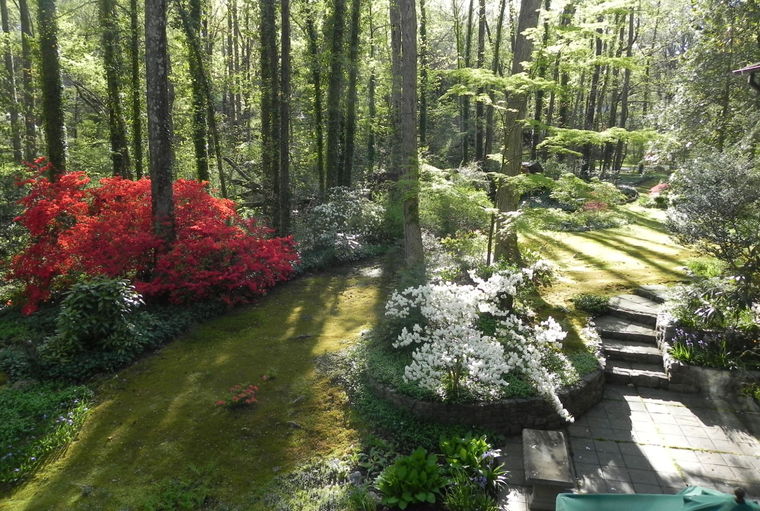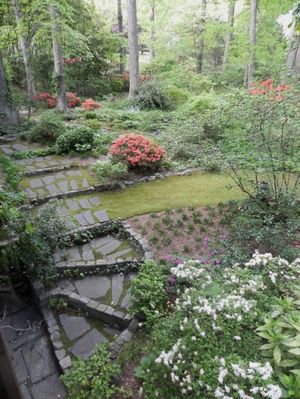
As sunlight changes throughout the day, so do the colors of the mosses at Eden Woods. photo by Norie Burnet
Keep it or kill it? While many homeowners and gardeners consider moss a nuisance, others have learned to appreciate its beauty and benefits. Over a 35-year span, Bon Air resident Norie Burnet grew to love moss and now cultivates it with passion.
“I never, ever thought about a moss garden, but it kept creeping in while I was trying to garden,” she said. Her son thought the moss was beautiful and encouraged her to give it a chance to grow. “I started looking at moss in a different way, appreciating it and nurturing it. The rest is history.”
Burnet developed close to an acre of native mosses around her residence, which is named Eden Woods (we’ve written about our staff field trips there on this blog before). She cultivated different “garden rooms” that range from a Spring Pool Garden with moss-covered rocks to a mossy Sunken Garden, Circle Garden and Step Garden with winding trails. The area’s acidic soil (around 5.5 pH), cool shade and humidity are ideal for growing mosses. Available moisture is especially important since moss is a non-systemic plant, meaning it lacks a water-conducting system and conventional roots.
Nature’s bounty of mosses offers varying heights, textures and growth patterns for different applications. Moss can serve as a focal point, create a lush backdrop for other plants and garden ornaments or act as a low-growing ground cover that builds soil and helps to combat erosion. It also adds color and interest where plants typically cannot grow, such as between pavers, in rock crevices and at the base of trees.
Burnet, a former teacher and master gardener who enjoys watercolor painting, considers the moss gardens her palette and inspiration. Sunlight splashes on the mosses in varied ways throughout the day, creating an ever-changing vista in every imaginable shade of green.
Moss is “green” in another way, too, since it is environmentally friendly. Like other plants, moss pulls toxins out of the air, and in the right conditions is a unique alternative to highly cultivated lawns. “Grass needs so many things that fight nature — weed killers and fertilizers that get into our water — but moss has a way of working with nature,” Burnet said. “Working with the environment is a more sane and enjoyable way of gardening.”
Though moss takes time to establish, Burnet claims it is worth the wait.
“Gardens of moss become a sacred place, a cathedral in the woods where people tend to lower their voices,” she said. “It creates a mood of quietness and meditation that is a haven, and it never ceases to amaze me how beautiful it can be, especially after a rain.”
Editor’s Note: This article first published in the Richmond Times-Dispatch, in September 2014.
